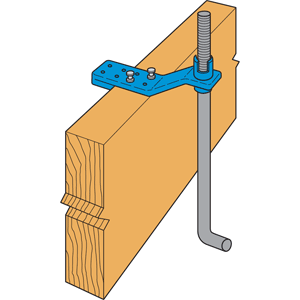Quote Originally Posted by KZQuixote View Post
"As a contractor, I've had problems with too short anchor bolts many times." To which ICE replies: "When I really need to remember something, I ask my wife to remind me."
I'm wondering: Are you her apprentice?
Never done much carpentry have you ICE? To which ICE replies "There, I fixed it for you"
I'm telling ICE that a carpentry apprenticeship requires four years of concentrated effort, don't discount it!
2X plate? What's wrong with an additional piece of 2X plate between the studs to cover the 1 7/8" length? ICE's reply: Limited utility. One just can't get blocks in everywhere. There is always a need for epoxy bolts when there is a lot of it.
Never tried it have you?
If you don't like that how about two minutes of concrete chiseling to get the 1 7/8" ICE's reply: Does your dentist come out and clean the threads?
Never tried it have you?
Not going for either of those, how about a 1/2" stack of 1" washers over the protruding coupling nut? ICE replies: lucky you, it's usually near a 2" stack and what about the 3"sq. washer, do you drill it or buy one with a hole big enough to clear the coupler?
I'm the solution guy, you're the approval guy!
Any of these are WAY better that drilling and epoxying in additional anchors. ICE's reply". "Do you not own a drill?"
That's less than cogent!
I ALWAYS get a laugh out of you folks who jump at the most painful option without trying to find a win-win outcome. ICE's reply: The owners must wonder if they are the loser"
Proally so, but you presume that they’d come down on your side.
60 or even a hundred times would be way more efficient and effective than epoxy and Special Inspection.
ICE's reply: "I suppose, that once you get it down to a system and buy hardware in bulk, it still won't be cheaper than a tape measure."
Dude, your naivete reveals you! Short anchor bolts seldom result from the measurement errors you imagine. It certainly does not take an inspector to measure the height of an anchor bolt relative to the top of the form. Most of the time one subcontractor is responsible for the foundation and a DIFFERENT subcontractor steps in to do the framing. Every time I’ve signed a contract to frame a building I shoot the tops of the stem walls. More often than not I decide that some areas need to be raised to match the highest sections. Get ready now! I have to shim up and dry pack my plates to keep a level grade and, keep your focus here, I have to deal with anchor bolts that are TOO SHORT!
In the case I mentioned, obviously they were not aware that 3x plate was required. Had I not caught it, the odds are pretty good that they would have framed the walls with 2x plate. Of course, you know the fix for that. Here's a tip for next time. Use pressure treated as it doesn't split as readily as untreated when you stitch nail the blocks.
To which I reply that PT wood is generally of the lowest grade. Good luck stitch nailing it.
Course, cause you caught it, they will now use the 3" plates and the coupling nuts and bolts will work just fine without any epoxy or special inspections.
Thanks Bill, you provided a fun break from the routine and I discovered a few tools. Just look at the color and I can shout too.
Thanks Tiger, this exchange has been quite revealing from this side as well.
Bill

